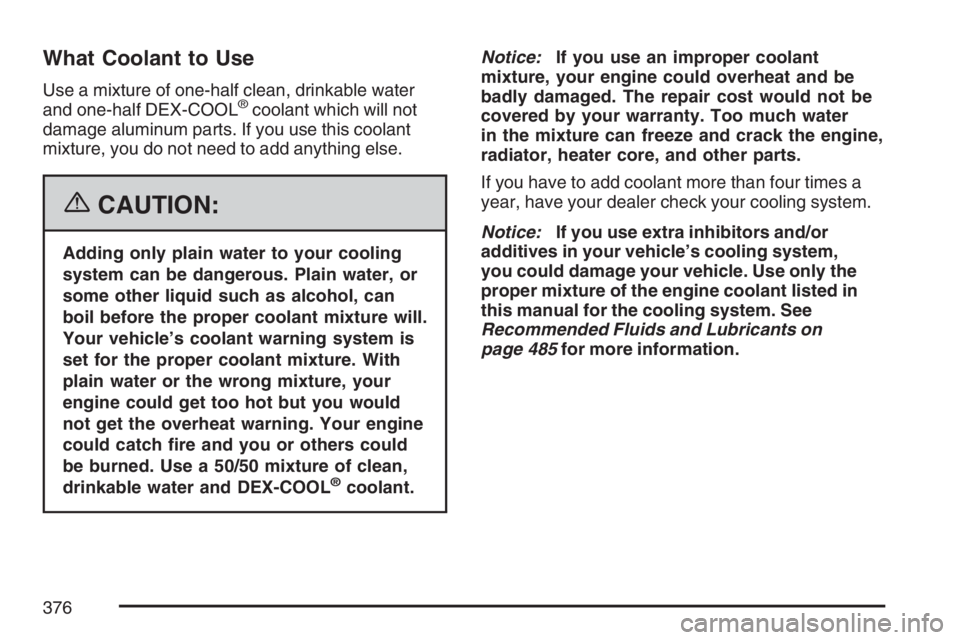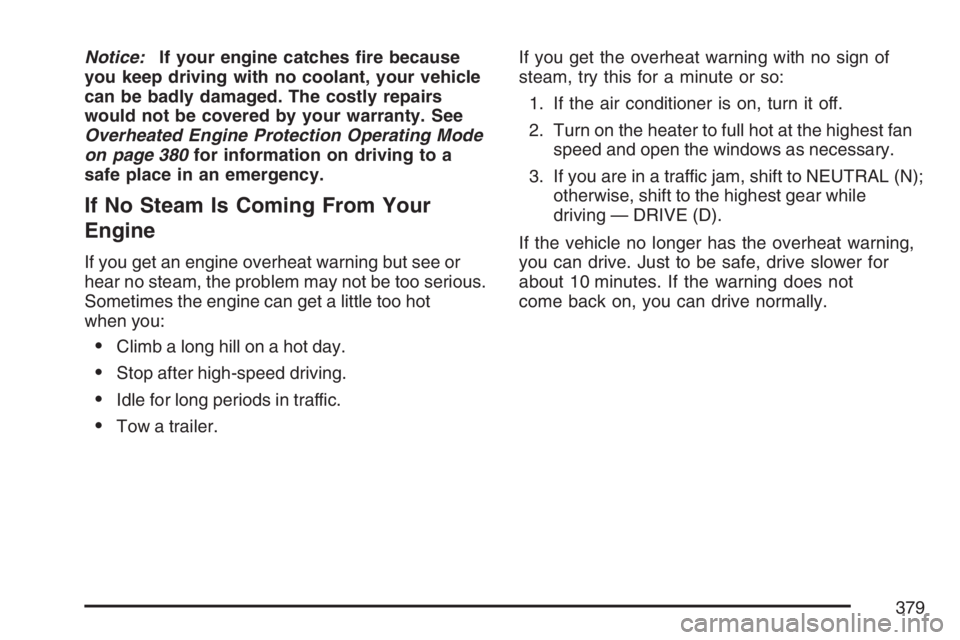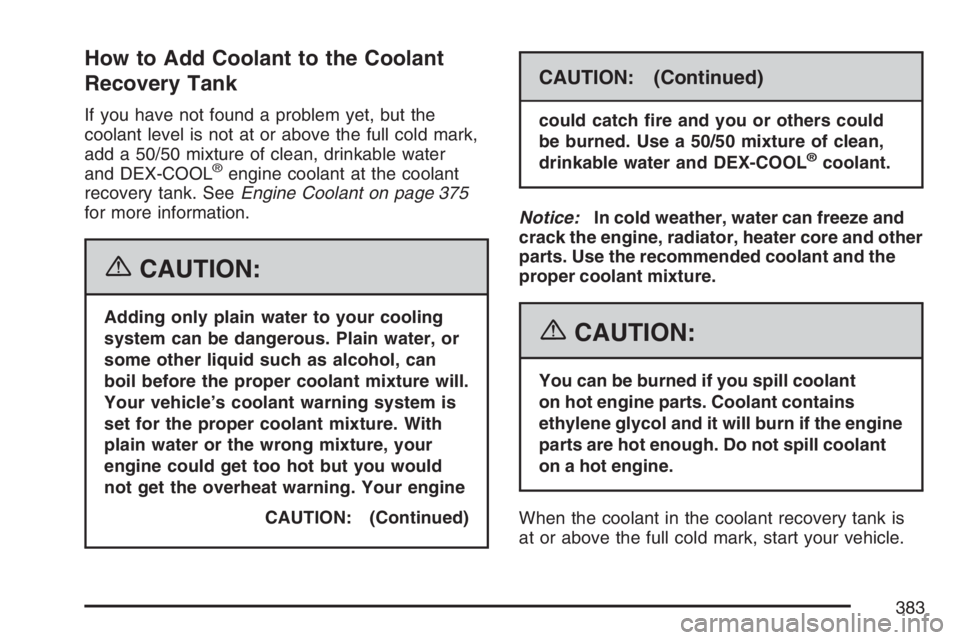heater BUICK RANDEZVOUS 2007 Owner's Manual
[x] Cancel search | Manufacturer: BUICK, Model Year: 2007, Model line: RANDEZVOUS, Model: BUICK RANDEZVOUS 2007Pages: 528, PDF Size: 2.99 MB
Page 11 of 528

Heated Seats
Your vehicle may have
heated seats. If it does,
the heated seat
switches are located in
the instrument panel
switchbank.
This feature will quickly heat the seat cushions
and lower back of the driver’s and front
passenger’s seat. The left switch is for the driver’s
seat and the right switch is for the front
passenger’s seat.
Press the top of the switch to turn the heater on.
Press the bottom of the switch to turn the
heater off. The heated seat switch will turn off
when the ignition is turned to OFF and will resume
operation when the ignition is turned to ON,
unless the switch is turned off.
Memory Seat and Mirrors
If your vehicle has this
feature, the controls are
located on the driver’s
door panel and are used
to store and recall the
driver’s seat position
and the outside rearview
mirror position.
The settings for these features can be
personalized for both driver 1 and driver 2.
Driver 1 and driver 2 correspond to the memory
buttons labeled 1 and 2 on the driver’s door and to
the numbers, 1 or 2, on the back of the remote
keyless entry transmitters.
11
Page 107 of 528

Keys............................................................ 109
Remote Keyless Entry System.................. 110
Remote Keyless Entry System
Operation............................................... 111
Doors and Locks........................................ 114
Door Locks................................................ 114
Power Door Locks..................................... 115
Delayed Locking........................................ 116
Programmable Automatic Door Locks........ 116
Rear Door Security Locks......................... 116
Lockout Protection..................................... 118
Liftgate...................................................... 118
Windows...................................................... 120
Power Windows........................................ 121
Sun Visors................................................ 122
Theft-Deterrent Systems............................. 122
Content Theft-Deterrent............................. 122
PASS-Key
®III ........................................... 124
PASS-Key®III Operation........................... 125Starting and Operating Your Vehicle......... 127
New Vehicle Break-In................................ 127
Ignition Positions....................................... 128
Retained Accessory Power (RAP)............. 129
Starting the Engine.................................... 129
Engine Coolant Heater.............................. 131
Automatic Transaxle Operation.................. 132
Parking Brake........................................... 135
Shifting Into Park (P) ................................. 136
Shifting Out of Park (P)............................. 138
Parking Over Things That Burn................. 139
Engine Exhaust......................................... 140
Running the Engine While Parked............. 141
Mirrors......................................................... 142
Manual Rearview Mirror............................. 142
Outside Power Mirror................................ 142
Outside Curb View Assist Mirror................ 143
Outside Convex Mirror............................... 143
Outside Heated Mirrors............................. 143
OnStar®System.......................................... 144
Section 2 Features and Controls
107
Page 131 of 528

Engine Coolant Heater
Your vehicle may have an engine coolant heater.
In very cold weather, 0°F (−18°C) or colder,
the engine coolant heater can help. You will get
easier starting and better fuel economy during
engine warm-up.
Usually, the coolant heater should be plugged in a
minimum of four hours prior to starting your
vehicle. At temperatures above 32°F (0°C), use of
the coolant heater is not required. Your vehicle
may also have an internal thermostat in the
plug end of the cord. This will prevent operation of
the engine coolant heater when the temperature
is at or above 0°F (−18°C) as noted on the cord.
To Use the Engine Coolant Heater
1. Turn off the engine.
2. Open the hood and unwrap the electrical
cord. The electrical cord is located on the
driver’s side of the engine compartment.
3. Plug it into a normal, grounded 110-volt AC
outlet.
{CAUTION:
Plugging the cord into an ungrounded
outlet could cause an electrical shock.
Also, the wrong kind of extension cord
could overheat and cause a �re. You
could be seriously injured. Plug the cord
into a properly grounded three-prong
110-volt AC outlet. If the cord will not
reach, use a heavy-duty three-prong
extension cord rated for at least 15 amps.
4. Before starting the engine, be sure to unplug
and store the cord as it was before to keep it
away from moving engine parts. If you do
not, it could be damaged.
How long should you keep the coolant heater
plugged in? The answer depends on the outside
temperature, the kind of oil you have, and some
other things. Instead of trying to list everything here,
we ask that you contact your dealer in the area
where you will be parking your vehicle. The dealer
can give you the best advice for that particular area.
131
Page 331 of 528

You will need a well-charged battery to restart the
vehicle, and possibly for signaling later on with
your headlamps. Let the heater run for a while.
Then, shut the engine off and close the window
almost all the way to preserve the heat. Start
the engine again and repeat this only when you
feel really uncomfortable from the cold. But do it as
little as possible. Preserve the fuel as long as
you can. To help keep warm, you can get out of
the vehicle and do some fairly vigorous exercises
every half hour or so until help comes.
If Your Vehicle is Stuck in Sand,
Mud, Ice, or Snow
In order to free your vehicle when it is stuck, you
will need to spin the wheels, but you do not
want to spin your wheels too fast. The method
known as rocking can help you get out when you
are stuck, but you must use caution.
{CAUTION:
If you let your vehicle’s tires spin at high
speed, they can explode, and you or
others could be injured. And, the
transaxle or other parts of the vehicle can
overheat. That could cause an engine
compartment �re or other damage. When
you are stuck, spin the wheels as little as
possible. Do not spin the wheels above
35 mph (55 km/h) as shown on the
speedometer.
Notice:Spinning the wheels can destroy parts
of your vehicle as well as the tires. If you
spin the wheels too fast while shifting
the transaxle back and forth, you can destroy
the transaxle. SeeRocking Your Vehicle to
Get It Out on page 332.
For information about using tire chains on your
vehicle, seeTire Chains on page 424.
331
Page 375 of 528

Engine Coolant
The cooling system in your vehicle is �lled with
DEX-COOL®engine coolant. This coolant is
designed to remain in your vehicle for 5 years or
150,000 miles (240 000 km), whichever occurs
�rst, if you add only DEX-COOL
®extended
life coolant.
The following explains your cooling system and
how to add coolant when it is low. If you have
a problem with engine overheating, seeEngine
Overheating on page 378.A 50/50 mixture of clean, drinkable water and
DEX-COOL
®coolant will:
Give freezing protection down to−34°F
(−37°C).
Give boiling protection up to 265°F (129°C).
Protect against rust and corrosion.
Help keep the proper engine temperature.
Let the warning messages and gages work as
they should.
Notice:Using coolant other than DEX-COOL
®
may cause premature engine, heater core, or
radiator corrosion. In addition, the engine
coolant may require changing sooner, at
the �rst maintenance service after each
30,000 miles (50 000 km) or 24 months,
whichever occurs �rst. Any repairs would not
be covered by your warranty. Always use
DEX-COOL
®(silicate-free) coolant in your
vehicle.
375
Page 376 of 528

What Coolant to Use
Use a mixture of one-half clean, drinkable water
and one-half DEX-COOL®coolant which will not
damage aluminum parts. If you use this coolant
mixture, you do not need to add anything else.
{CAUTION:
Adding only plain water to your cooling
system can be dangerous. Plain water, or
some other liquid such as alcohol, can
boil before the proper coolant mixture will.
Your vehicle’s coolant warning system is
set for the proper coolant mixture. With
plain water or the wrong mixture, your
engine could get too hot but you would
not get the overheat warning. Your engine
could catch �re and you or others could
be burned. Use a 50/50 mixture of clean,
drinkable water and DEX-COOL
®coolant.Notice:If you use an improper coolant
mixture, your engine could overheat and be
badly damaged. The repair cost would not be
covered by your warranty. Too much water
in the mixture can freeze and crack the engine,
radiator, heater core, and other parts.
If you have to add coolant more than four times a
year, have your dealer check your cooling system.
Notice:If you use extra inhibitors and/or
additives in your vehicle’s cooling system,
you could damage your vehicle. Use only the
proper mixture of the engine coolant listed in
this manual for the cooling system. See
Recommended Fluids and Lubricants on
page 485for more information.
376
Page 379 of 528

Notice:If your engine catches �re because
you keep driving with no coolant, your vehicle
can be badly damaged. The costly repairs
would not be covered by your warranty. See
Overheated Engine Protection Operating Mode
on page 380for information on driving to a
safe place in an emergency.
If No Steam Is Coming From Your
Engine
If you get an engine overheat warning but see or
hear no steam, the problem may not be too serious.
Sometimes the engine can get a little too hot
when you:
Climb a long hill on a hot day.
Stop after high-speed driving.
Idle for long periods in traffic.
Tow a trailer.If you get the overheat warning with no sign of
steam, try this for a minute or so:
1. If the air conditioner is on, turn it off.
2. Turn on the heater to full hot at the highest fan
speed and open the windows as necessary.
3. If you are in a traffic jam, shift to NEUTRAL (N);
otherwise, shift to the highest gear while
driving — DRIVE (D).
If the vehicle no longer has the overheat warning,
you can drive. Just to be safe, drive slower for
about 10 minutes. If the warning does not
come back on, you can drive normally.
379
Page 382 of 528

The coolant level should be at or above the full
cold mark. If it is not, you may have a leak at the
pressure cap or in the radiator hoses, heater hoses,
radiator, water pump, or somewhere else in the
cooling system.
{CAUTION:
Heater and radiator hoses, and other
engine parts, can be very hot. Do not
touch them. If you do, you can be burned.
Do not run the engine if there is a leak.
If you run the engine, it could lose all
coolant. That could cause an engine �re,
and you could be burned. Get any leak
�xed before you drive the vehicle.If there seems to be no leak, with the engine on,
check to see if the electric engine cooling fans
are running. If the engine is overheating, both fans
should be running. If they are not, your vehicle
needs service.
Notice:Engine damage from running your
engine without coolant is not covered by your
warranty. SeeOverheated Engine Protection
Operating Mode on page 380for information on
driving to a safe place in an emergency.
Notice:Using coolant other than DEX-COOL
®
may cause premature engine, heater core, or
radiator corrosion. In addition, the engine
coolant could require changing sooner, at
30,000 miles (50 000 km) or 24 months,
whichever occurs �rst. Any repairs would not
be covered by your warranty. Always use
DEX-COOL
®(silicate-free) coolant in your
vehicle.
382
Page 383 of 528

How to Add Coolant to the Coolant
Recovery Tank
If you have not found a problem yet, but the
coolant level is not at or above the full cold mark,
add a 50/50 mixture of clean, drinkable water
and DEX-COOL
®engine coolant at the coolant
recovery tank. SeeEngine Coolant on page 375
for more information.
{CAUTION:
Adding only plain water to your cooling
system can be dangerous. Plain water, or
some other liquid such as alcohol, can
boil before the proper coolant mixture will.
Your vehicle’s coolant warning system is
set for the proper coolant mixture. With
plain water or the wrong mixture, your
engine could get too hot but you would
not get the overheat warning. Your engine
CAUTION: (Continued)
CAUTION: (Continued)
could catch �re and you or others could
be burned. Use a 50/50 mixture of clean,
drinkable water and DEX-COOL
®coolant.
Notice:In cold weather, water can freeze and
crack the engine, radiator, heater core and other
parts. Use the recommended coolant and the
proper coolant mixture.
{CAUTION:
You can be burned if you spill coolant
on hot engine parts. Coolant contains
ethylene glycol and it will burn if the engine
parts are hot enough. Do not spill coolant
on a hot engine.
When the coolant in the coolant recovery tank is
at or above the full cold mark, start your vehicle.
383
Page 516 of 528

Collision Damage Repair............................. 504
Comfort Guides, Rear Safety Belt................. 53
Compact Spare Tire.................................... 450
Compass..................................................... 238
Content Theft-Deterrent............................... 122
Control of a Vehicle..................................... 306
Convenience Center, Rear........................... 165
Convenience Net......................................... 164
Coolant
Engine Temperature Gage........................ 221
Engine Temperature Warning Message.... 227
Heater, Engine......................................... 131
SGCM, Surge Tank Pressure Cap............ 226
Cooling System........................................... 381
Cruise Control............................................. 181
Cupholder(s)................................................ 158
Customer Assistance Information
Courtesy Transportation........................... 501
Customer Assistance for Text
Telephone (TTY) Users......................... 496
Customer Assistance Offices.................... 496
Customer Satisfaction Procedure.............. 492
GM Mobility Reimbursement Program...... 497
Reporting Safety Defects to
General Motors..................................... 509
Reporting Safety Defects to the
Canadian Government.......................... 509Customer Assistance Information (cont.)
Reporting Safety Defects to the
United States Government.................... 508
Roadside Assistance Program.................. 498
Service Publications Ordering
Information........................................... 510
D
Daytime Running Lamps............................. 186
Defensive Driving........................................ 302
Delayed Lighting.......................................... 190
Delayed Locking.......................................... 116
DIC Compass.............................................. 238
Doing Your Own Service Work.................... 355
Door
Ajar Warning Message............................. 230
Delayed Locking...................................... 116
Locks....................................................... 114
Power Door Locks................................... 115
Programmable Automatic Door Locks....... 116
Rear Door Security Locks........................ 116
Driver
Position, Safety Belt................................... 36
Driver Information Center (DIC)................... 235
DIC Controls and Displays....................... 236
516